Roman social clubs and guilds—known as collegia and sodalitates—were voluntary associations essential to networking in antiquity’s business world. These groups united individuals around shared professions, religious devotion, or local community interests. They provided a framework for economic cooperation, mutual aid, and social identity within the complex fabric of ancient Rome.
These associations functioned as early platforms for business networking and collective economic activity. The trade and economy in Ancient Rome were foundational to its vast empire, influencing both daily life and long-term stability. Such economic practices were not just limited to trade; they also played a significant role in political messaging. Coins, for instance, were used as powerful tools by emperors to convey their authority and legitimacy. These small pieces of currency went beyond their basic purpose and became significant instruments for political messaging.
Key aspects include:
- Definition: Organized bodies of artisans, merchants, and citizens cooperating voluntarily
- Significance: Facilitated trade regulation, resource pooling, and dispute resolution
- Role: Crucial in shaping Rome’s social and commercial networks
Historical Background of Roman Social Clubs and Guilds
The history of collegia traces back to Rome’s regal period, before 509 B.C.E., when voluntary associations began forming among the city’s inhabitants. These early groups often consisted of artisans, merchants, and laborers who united to protect economic interests and maintain social bonds.
Key features of these origins include:
- Collective efforts to safeguard trade secrets and standardize prices
- Mutual support in times of hardship or legal disputes
- Informal gatherings evolving into more structured organizations
During the Roman Republic, collegia expanded in number and complexity. Associations served not only professional purposes but also social and religious functions. The Republic era saw increased regulation as authorities recognized their importance yet remained cautious about potential political implications.
With the advent of the Empire, collegia adapted to new administrative frameworks. Imperial policies sometimes encouraged guild activities for urban management while restricting any groups perceived as threats. Throughout these periods, Roman guilds maintained essential roles in economic cooperation, social identity, and community organization across a vast empire.
This era also witnessed a flourishing of Roman art, which emerged from the confluence of various cultures. This artistic tradition reflects not only the aesthetic values of its time but also the social, political, and cultural dynamics that shaped the Roman world.
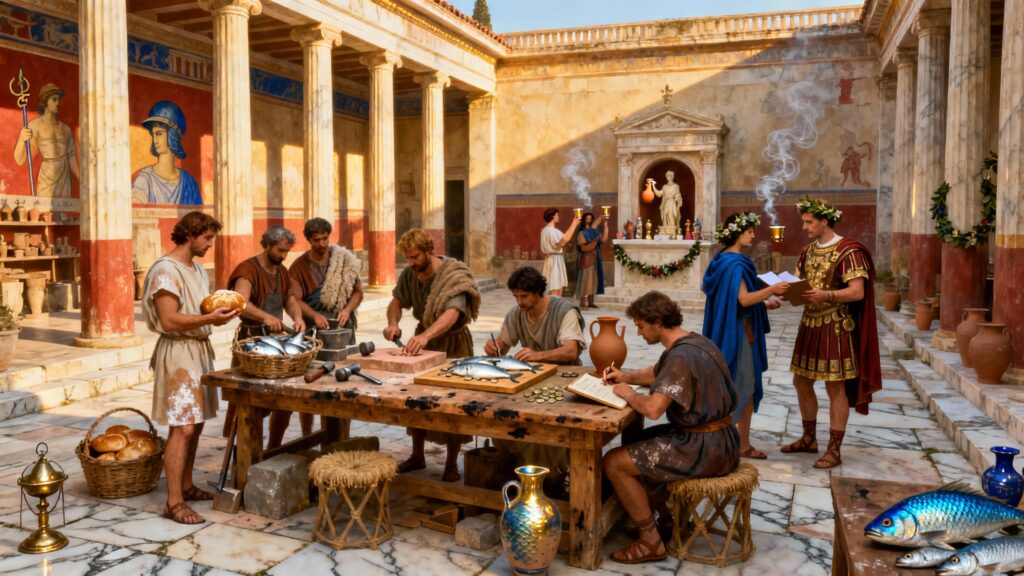
Types and Functions of Roman Social Clubs and Guilds
Roman social clubs, or collegia, took on diverse forms depending on their members’ needs and common interests. These types of collegia can be broadly categorized by profession, mutual aid purpose, or local community focus.
1. Professional Guilds
Tradespeople organized themselves into associations to protect economic interests and promote quality standards. Common guilds included:
- Bakers who controlled bread production and distribution
- Cloth merchants overseeing textile trade
- Fullers responsible for processing and cleaning fabrics
- Fishermen coordinating catches and sales
- Stonemasons managing construction work
- Potters regulating ceramic craftsmanship
Such guilds pooled resources for bulk purchasing supplies, shared tools, and even sponsored religious festivals honoring patron deities related to their crafts. This collective approach helped maintain fair pricing, ensured reliability in trade, and established reputations that benefited all members.
2. Burial Societies
These associations provided mutual aid by collecting dues to fund funerals and burial expenses. In a society where proper funeral rites were essential for social status and spiritual peace, these clubs offered security against unexpected costs. Members could rely on dignified ceremonies even if personal wealth was insufficient.
3. Neighborhood or District Associations
Residents within city quarters banded together to manage communal responsibilities such as:
- Security patrols guarding streets at night
- Cleaning public spaces to maintain urban order
- Organizing community festivals that reinforced local identity
- Maintaining shrines and small temples
These groups fostered a sense of belonging while contributing practical services that enhanced daily life in Rome’s crowded urban environments.
The variety among collegia reflects a complex social fabric where economic cooperation, mutual support, and civic engagement overlapped within the Roman world.
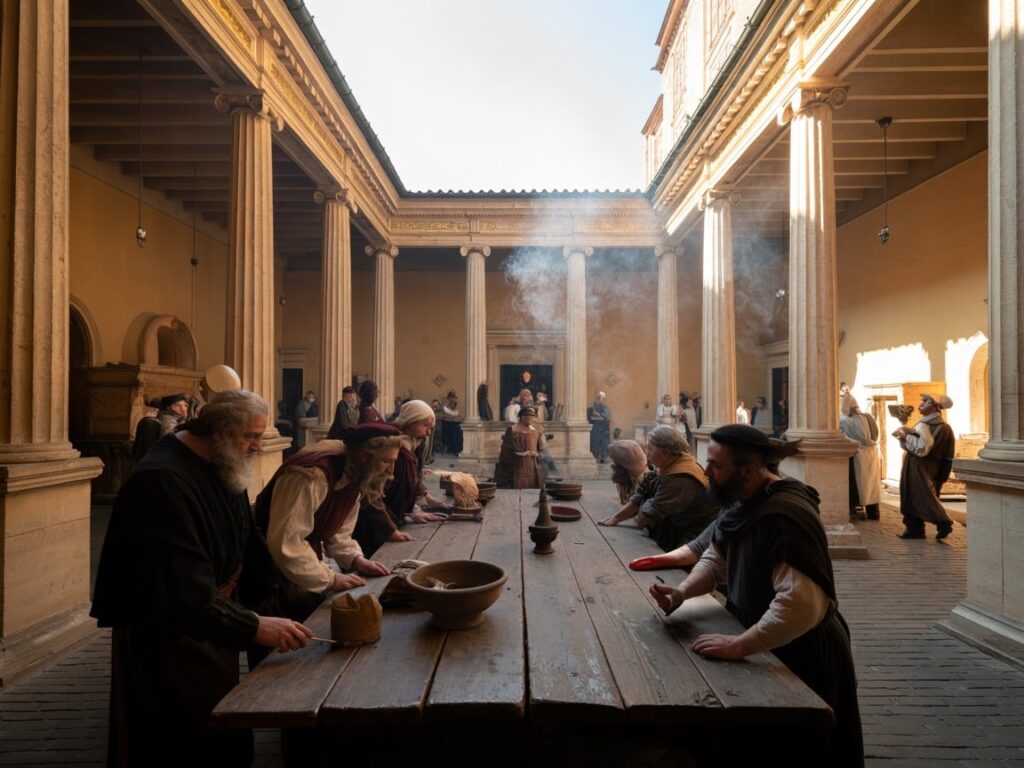
Activities and Leadership Structures in Collegia
Roman social clubs and guilds thrived on active participation and well-organized management. Mutual aid in antiquity found its expression through various practical activities that promoted economic cooperation among members.
Activities in Collegia
- Pooling Resources: Members commonly contributed dues or pooled funds to purchase supplies in bulk, securing better prices and reliable access to materials essential for their trades. This collective buying power enhanced competitiveness while reducing individual risks related to supply shortages or price fluctuations.
- Shared Workshops and Equipment: Some collegia maintained communal workshops or tools available to all members. This arrangement lowered barriers to entry for less wealthy artisans, fostering inclusivity within the profession.
- Financial Support: Funds collected also covered emergency aid for sick or injured members, ensuring a safety net beyond mere business interests.
Leadership Structures in Collegia
Leadership roles were clearly defined to maintain order and accountability within these associations:
- Administrators (Magistri or Presidents): Elected officials oversaw daily operations, organized meetings and events, and represented the collegium’s interests externally. Their role was crucial in maintaining cohesion and enforcing rules.
- Treasurers (Quaestors): Responsible for managing the club’s finances, treasurers handled dues collection, budgeting for festivals, religious offerings, and burial expenses. Transparent financial management reinforced trust among members.
- Secretaries (Scribae): They recorded minutes of meetings, membership lists, and other official documents vital for continuity and legal recognition.
Such structures ensured collegia operated efficiently as both social and economic entities. However, it’s important to note that these leadership roles were not immune to challenges. Political instability and weak leadership could undermine their effectiveness, reflecting a broader trend observed during the decline of the Western Roman Empire.
The intertwining of Roman guild activities with organized leadership strengthened bonds within the trade community while enabling coordinated action. These features made Roman social clubs essential hubs of networking in antiquity’s business world.
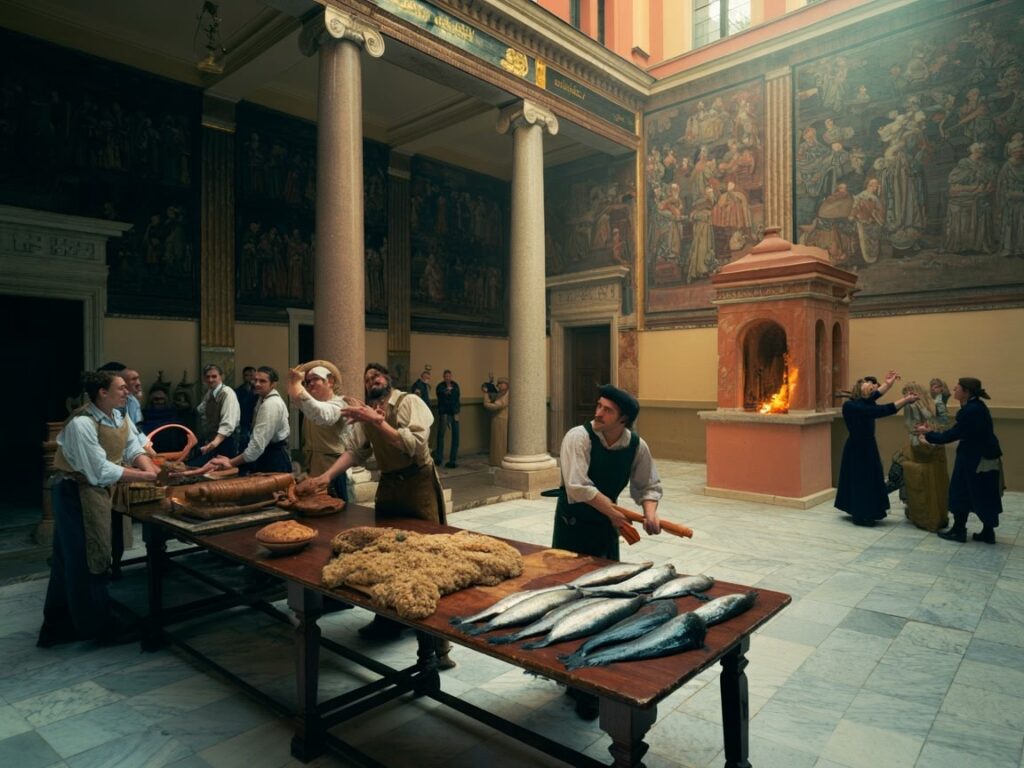
The Religious Dimension of Roman Social Clubs: Patron Deities and Ritual Banquets
Religious practices in collegia were deeply woven into the fabric of these social and professional networks. Each club often honored specific patron deities in Rome, tied closely to their trade or community. This sacred dedication served multiple purposes:
- Seeking divine favor: Members believed that worshipping gods related to their craft or business would bring success, protection, and prosperity.
- Strengthening group identity: Shared religious devotion created a powerful bond among members, reinforcing loyalty and mutual support.
- Guiding ethical conduct: Rituals and prayers reminded participants to uphold honesty and fairness in their dealings.
Typical patron gods included Mercury for merchants and traders, Minerva for artisans and craftsmen, and Neptune for fishermen. Clubs held regular ceremonies involving sacrifices, offerings, and prayer sessions directed toward these deities. These rituals and sacrifices were essential for maintaining good relationships with the divine.
Ritual banquets played a central role. These gatherings combined socializing with religious observance:
- Members shared food and wine during festive meals.
- Toasts honored patron gods, invoking blessings on work and livelihood.
- Public displays of piety affirmed the club’s status within the wider community.
Such integration of religion underscored how Roman social clubs functioned as more than economic cooperatives—they were spiritual communities united by common faith in divine power influencing everyday life. The evolution of Roman sculpture, often depicting these patron deities, further illustrates the intertwining of religion with daily life in ancient Rome.
Networking Benefits within the Roman Business World: Trust, Trade Connections, and Local Identities
Roman collegia served as vital platforms for business networking antiquity, enabling members to build trust and establish reliable trade connections. These associations created an environment where artisans, merchants, and laborers could interact regularly, fostering mutual confidence essential for commerce in a vast empire.
Key networking benefits included:
Trust and Fair Dealings: Membership in a collegium implied adherence to shared standards of quality and honesty. This reputation mechanism reduced risks in transactions, as buyers and sellers recognized each other through the guild’s endorsement.
Price Regulation: Guilds often set agreed-upon prices for goods and services among members. This prevented destructive price wars that could undermine livelihoods and ensured stability in local markets.
Dispute Resolution: Collegia acted as internal courts mediating conflicts between members. Their authority avoided costly legal battles and maintained harmony necessary for ongoing business relationships.
Trade Connections and Information Exchange: Members shared market intelligence about supply sources, demand fluctuations, and new techniques. This knowledge exchange improved competitiveness beyond individual capacity.
Local Identity Reinforcement: Being part of a collegium strengthened a member’s sense of belonging within their city or district. Shared rituals and communal events deepened social bonds that supported economic collaboration.
The collegia economic impact extended beyond simple trade coordination; these groups formed the backbone of commercial trust networks that sustained Rome’s complex economy. Their role in organizing fair practices and facilitating cooperation helped stabilize markets within an otherwise sprawling and diverse empire. As highlighted in this study, the influence of collegia was profound, shaping not just individual businesses but the economic landscape of Rome itself.
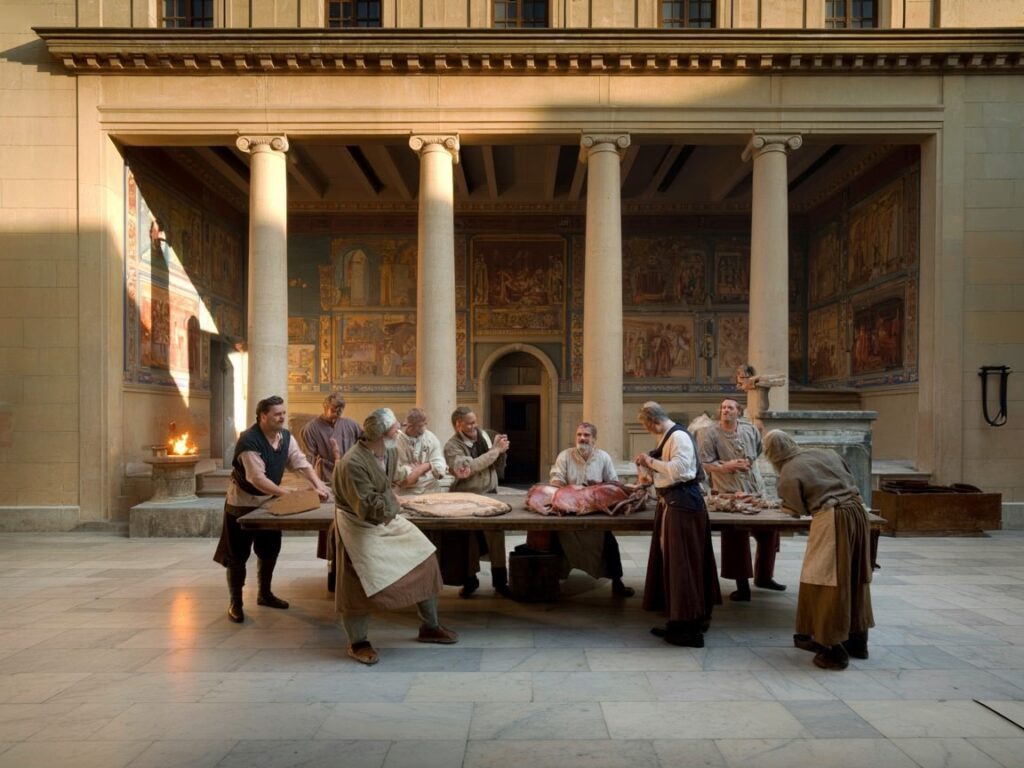
Civic Roles of Neighborhood Associations: Local Governance, Community Festivals, and Urban Order
Roman neighborhood associations played a crucial role in managing various civic responsibilities to maintain order and foster community spirit. These groups acted as intermediaries between the municipal authorities and residents, ensuring daily urban life ran smoothly.
Key functions included:
- Security patrols: Members organized watches to keep neighborhoods safe from theft or disturbances. This grassroots policing helped supplement official law enforcement in busy urban centers.
- Street cleaning: Maintaining cleanliness was a collective effort. Neighborhood associations coordinated regular cleaning of streets and public spaces to promote hygiene and civic pride.
- Organization of public festivals: Celebrations honoring gods, emperors, or local traditions were planned and executed by these groups. Festivals reinforced social bonds and local identities, drawing residents together in shared cultural expression.
- Maintenance of shrines: Many districts contained small temples or altars dedicated to patron deities. Associations assumed responsibility for their upkeep and ritual offerings, integrating religious observance into everyday community life.
Such activities illustrate how Roman social clubs extended beyond economic cooperation into the realm of urban order. They fostered a sense of belonging while addressing practical needs related to safety, cleanliness, and cultural continuity within their neighborhoods. This blend of social engagement and municipal service highlights the multifaceted nature of Roman Social Clubs and Guilds: Networking in Antiquity’s Business World.
Challenges, Regulation by Roman Authorities, and Interaction Between Early Christian Communities and Collegia
Roman authorities had mixed feelings about collegia. These social clubs offered clear benefits such as mutual aid, economic cooperation, and community organization. At the same time, large gatherings of citizens raised concerns about potential political unrest or conspiracies. The state carefully considered these risks when deciding on policies regarding collegia.
Roman laws on collegia often included restrictions aimed at controlling their size and influence. Several imperial edicts required new associations to register with local magistrates before formation, ensuring official oversight. Some emperors limited the number of members or forbade the creation of new clubs altogether in politically sensitive periods.
Key regulatory measures included:
- Mandatory registration to monitor membership and activities
- Restrictions on public meetings to prevent sedition
- Penalties for unauthorized or disruptive associations
The state’s approach reflected a desire to harness the positive aspects of collegia while minimizing threats to public order.
Early Christian communities encountered collegia as they spread through Roman society. Unlike traditional guilds, Christians rejected participation in rituals honoring pagan gods, which complicated their involvement in existing social clubs. Their assemblies emphasized spiritual fellowship over economic or political networking typical of collegia.
Christians navigated tensions by forming separate congregations that avoided idolatrous rites but still provided mutual support. This differentiation sometimes led to suspicion or persecution by Roman officials wary of unregistered or exclusive groups operating outside traditional frameworks.
The interaction between early Christians and collegia highlights the complex social dynamics within Rome’s voluntary associations under legal scrutiny and religious diversity.
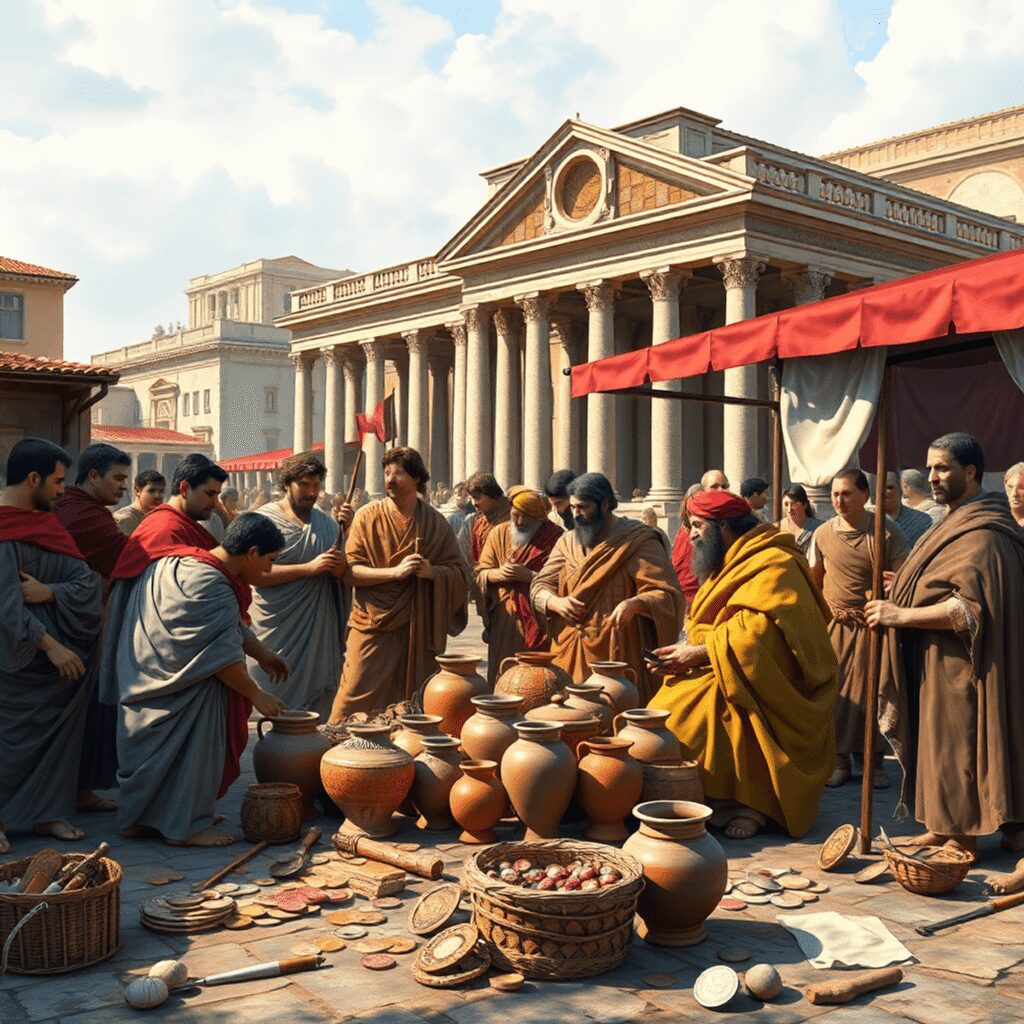
Legacy, Influence on Modern Networking Concepts: From Roman Guilds to Professional Associations
The historical roots of networking trace significantly back to the organization and function of Roman collegia. These early voluntary associations established a blueprint for structured cooperation among professionals that resonated through subsequent centuries.
Foundation for Medieval Guild Systems
Roman collegia provided critical models for medieval guilds in Europe. The concept of pooling resources, regulating trade practices, and mutual aid directly influenced the way guilds operated during the Middle Ages. They inherited the collegial structure of elected leadership, shared responsibilities, and communal rituals that reinforced group identity and economic stability.
Influence on Modern Professional Networking
The legacy of Roman guilds extends into contemporary professional associations. Modern networking groups echo these ancient practices by offering platforms for trust-building, knowledge exchange, and advocacy within specific trades or industries. Mutual aid societies today reflect the collegia’s role in providing social safety nets and community support beyond mere business interests.
Continuity of Social and Economic Functions
The blending of economic cooperation, social bonding, and ritual observance seen in Roman clubs set enduring precedents. You can observe similar dynamics in today’s chambers of commerce, trade unions, and industry-specific networks that balance professional development with collective welfare.
“The Roman collegium not only shaped its own era’s economy but planted seeds for organized collaboration that persist in modern networking frameworks.”
Understanding this legacy illuminates how deeply ingrained concepts of professional solidarity and mutual aid are in Western organizational history. This influence is not limited to networking alone. The enduring legacy of Roman law has significantly shaped modern legal systems across the globe. Furthermore, the intricate social structures established by Romans have laid the groundwork for many aspects of modern life, influencing everything from our legal systems to our architectural marvels.
Conclusion
The summary of Roman social clubs reveals their critical role in shaping early networking structures within antiquity’s bustling business environment. The importance of collegia lies not only in economic cooperation but also in fostering trust, shared identity, and mutual aid among members. These associations functioned as vital precursors to modern professional networks by:
- Creating frameworks for collaboration and resource sharing
- Establishing leadership roles and governance models
- Integrating social, religious, and civic dimensions into business interactions
Roman Social Clubs and Guilds: Networking in Antiquity’s Business World laid foundations that continue to influence how professionals connect and support one another today.
FAQs (Frequently Asked Questions)
What were Roman social clubs and guilds, and why were they significant in ancient Rome?
Roman social clubs and guilds, known as collegia and sodalitates, were voluntary associations that played a crucial role in the social and business landscape of ancient Rome. They facilitated networking, economic cooperation, and mutual aid among artisans, merchants, and laborers, serving as precursors to modern professional networks.
How did Roman collegia originate and evolve throughout history?
The origins of Roman collegia date back to Rome’s regal period before 509 B.C.E., initially formed by artisans, merchants, and laborers. These associations evolved through the Roman Republic and Empire periods, adapting to changing social and economic needs while maintaining their importance in community life.
What types of Roman social clubs and guilds existed, and what functions did they serve?
Roman collegia included various types such as professional guilds (bakers, cloth merchants, fullers, fishermen, stonemasons, potters), burial societies providing mutual aid for funeral arrangements, and neighborhood associations managing civic duties. These groups supported economic cooperation, social welfare, and local governance.
How did religious practices integrate into Roman social clubs and guilds?
Religious devotion was integral to Roman collegia; many groups dedicated themselves to patron deities seeking favor in business and crafts. Ritual banquets and ceremonies were common practices that reinforced communal bonds and invoked divine support for their professional endeavors.
In what ways did Roman guilds facilitate networking and economic cooperation among tradespeople?
Roman guilds fostered trust and fair dealings by regulating prices, resolving disputes, pooling resources for supplies, and establishing trade connections. This economic cooperation protected members against competition and enhanced their collective influence within the business world of antiquity.
What legacy have Roman social clubs and guilds left on modern professional networking concepts?
Roman collegia laid the groundwork for medieval guild systems and influenced contemporary ideas of professional networking and mutual aid societies. Their model of voluntary association for economic cooperation and social support continues to resonate in modern business networks.

